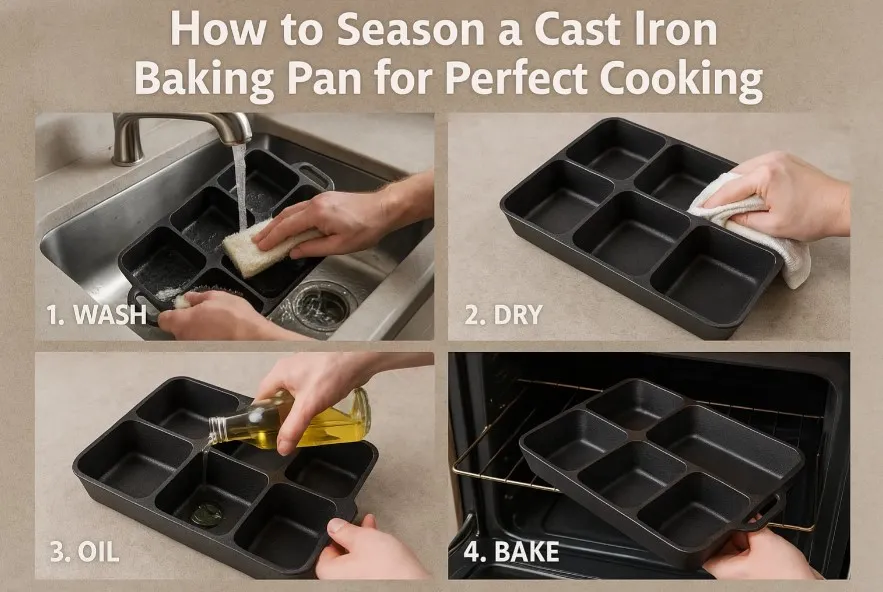Learn the simple steps to season your cast iron baking pan for a natural non-stick finish and flawless cooking every time!
Years ago, I ruined my favorite peach cobbler attempting to season a cast iron pan – the smoke alarm sang backup vocals. Since then, I’ve learned that pan seasoning isn’t about perfection.
It’s about a journey: hands dirty with oil, burns on your forearms (optional), and passed-down family secrets. If you’ve ever stared at your dull pan wondering if it’s worth it, you’re in the right place.

The Myth and Magic of Seasoning: Why Your Cast Iron Pan Isn’t Just a Skillet
When I first picked up a cast iron skillet, I thought seasoning was just about adding flavor. Turns out, seasoning cast iron is so much more—it’s about protecting your cast iron pan, making it nonstick, and ensuring it lasts for generations. If you’ve ever wondered why your grandmother’s cast iron cookware looks so smooth and shiny, it’s all thanks to proper seasoning.
Most modern cast iron pans, including baking pans, arrive pre-seasoned. But here’s the catch: that “seasoning” is often just a layer of industrial grease, not the kind of pan-love that builds a resilient, natural nonstick coating. Before you start cooking, it’s important to wash away that factory residue. Only then can you start building up the real magic—a patina that gets better with every use.
Seasoning cast iron means baking a thin layer of oil onto the pan at high heat. Research shows that this process, typically done at 400°F for 1–2 hours, creates a hard, easy-release surface. This isn’t just about making eggs slide off the skillet; it’s about protecting your pan from rust and boosting its durability. Every time you cook, you’re adding to that protective layer. The more you use your cast iron skillet, the better it gets.
It’s easy to think of seasoning as a one-time chore, but the truth is, the patina develops over time. Regular use and proper cleaning are key. Avoid harsh abrasives unless you’re stripping old seasoning, and remember: a well-seasoned cast iron pan is a joy to use. As Samin Nosrat says,
“A cast iron skillet is an heirloom in progress.”
Oils Ain’t Just Oils: Comparing Seasoning Oils for Your Cast Iron Baking Pan (TABLE)
When it comes to seasoning cast iron, the oil you choose really does matter. I’ve tried a handful over the years—flaxseed, canola, Crisco, even olive oil (which, trust me, was a sticky mess I won’t repeat). Each oil brings its own strengths and quirks to the table, and some are simply better suited for building that tough, non-stick finish we all want.

Let’s talk about the best oils for cast iron seasoning. Flaxseed oil is often recommended because it polymerizes—basically, it bonds and hardens—better than most. This creates a durable, slick surface. But here’s the catch: use too much, and you might end up with a flaky layer. I learned that the hard way. Canola oil and Crisco, on the other hand, are affordable, easy to find, and surprisingly effective. They’re forgiving and less likely to leave you with a sticky or uneven finish.
Research shows that the right oil can make all the difference in the longevity and performance of your seasoning layer. But no matter what oil you use, applying too much is a classic mistake. A thin, even coat is key. As Kenji López-Alt says:
“Choose your oil wisely—your pan’s personality depends on it.”
Here’s a quick comparison to help you decide which oil fits your needs:
| Oil | Polymerization | Notes |
|---|---|---|
| Flaxseed | Strong | Can flake if overused |
| Canola | Good | Affordable, reliable coverage |
| Crisco | Classic | Leaves smooth finish |
Choosing the right oil is a big step in cast iron seasoning and cast iron cleaning. Don’t be afraid to experiment, but remember: less is more.
The (Imperfect) Art of Seasoning: Step-by-Step from Flubs to Finish
Let’s get real about the seasoning process for your cast iron skillet or baking pan. If you’re like me, you might have started out thinking, “More oil means better seasoning, right?” I learned the hard way—my first attempt left me with a pan stickier than taffy on a summer sidewalk. Turns out, less is more when it comes to cast iron care.

Here’s what works, based on both research and real-world flubs:
- Wash: Start with a thorough scrub. If your pan is new, it probably has a layer of industrial grease. This is the one time steel wool and soap are your friends—use them to strip it all away.
- Dry: Water is the enemy of cast iron maintenance. Dry your pan completely, either with a towel or a quick trip over a burner.
- Oil Thinly: Apply a very thin layer of oil. Flaxseed, canola, or Crisco all work, but don’t overdo it. Multiple thin coats are better than one thick one.
- Bake: Place your pan upside down in a preheated oven at 400°F. Let it bake for up to 2 hours per layer. This high heat bonds the oil to the iron, creating that classic non-stick finish.
- Repeat if Needed: For a truly resilient surface, repeat the oil-and-bake process a few times.
For routine cast iron cleaning, skip the abrasives—just hot water and a brush will do. Only reach for steel wool if you’re stripping old seasoning.
“Perfection isn’t the point – a seasoned pan tells your story.” – Julia Turshen
| Step | Details |
|---|---|
| Steel wool | Only when stripping seasoning |
| Oven temp | 400°F |
| Seasoning time | Up to 2 hours/layer |
Troubleshooting & Triumphs: Common Mistakes, Fixes, and Success Stories (TABLE)
Seasoning cast iron isn’t always smooth sailing. If you’ve ever ended up with a sticky surface or a pan that just won’t stop rusting, you’re not alone. I’ve made my fair share of cast iron mistakes over the years, and each one taught me something new about cast iron care and maintenance.
- Sticky Surfaces or Gummy Finish? This usually happens when I use too much oil or don’t bake the pan long enough. Research shows that a thin, even layer of oil is key. If it’s sticky, I scrub it off with hot water and a gentle brush, dry thoroughly, and start the seasoning process again—just a little oil this time, baked at 400°F for an hour.
- Pan Rusting Again? Rust is a classic cast iron problem. It’s almost always due to moisture. My routine: scrub with steel wool, rinse, dry completely (sometimes I pop it in a warm oven to be sure), then re-season. Regular use and proper drying are essential for cast iron durability.
- Acidic Foods Breaking Down Seasoning? Tomato sauce and vinegar can strip away fresh seasoning. I avoid cooking acidic foods until the seasoning is well established.
One of my favorite cast iron success stories is my cousin’s. He found a rusty, neglected pan at a yard sale. With some elbow grease and patience, he brought it back to life. Now, it’s the star of every family brunch—proof that perseverance pays off in cast iron maintenance.
“Every blackened, glossy surface is the result of patient tinkering—and a few missteps.” – Sean Brock
Remember, troubleshooting early mistakes is key to achieving that gorgeous, glossy finish. Cast iron care is a journey, not a sprint.
Seasoning Isn’t a Science Project—It’s Cast Iron Camaraderie
After countless rounds of cast iron seasoning, I’ve realized that perfection isn’t the goal—connection is. Every cast iron baking pan in my kitchen has a story, from the first time I tried to bake bread and ended up with a smoky oven, to the golden cornbread that slid out effortlessly after a fresh round of seasoning. These aren’t just kitchen mishaps or triumphs; they’re the marks of tradition and experimentation that make cast iron cookware so special.

Research shows that seasoning isn’t about achieving a flawless, glassy surface. It’s about building flavor, resilience, and a sense of ritual. Each time I apply a thin layer of oil and slide my pan into a hot oven, I’m not just maintaining a tool—I’m participating in a tradition that cooks have shared for generations. The quirks, the uneven patches, even the occasional smoke cloud—these are all part of the cast iron benefits that make every pan unique.
What I love most about cast iron features is how they evolve with us. With every meal, the pan gets slicker, and my confidence grows. The more I use and care for my cast iron cookware, the more it feels like a kitchen companion—one that shares in every meal and memory. As Chrissy Teigen put it,
“A pan seasoned with memories always tastes better.”
So, let’s celebrate the quirks, the triumphs, and even the seasoning mishaps. Our cast iron pans aren’t just tools—they’re personal heirlooms, seasoned with stories as much as with oil. In the end, it’s not about science. It’s about camaraderie, tradition, and the joy of cooking together.
Frequently Asked Questions
How often should I season my cast iron pan?
Season it every few months or whenever food starts sticking. Regular use with oil helps maintain the coating.
Can I use olive oil for seasoning?
Olive oil has a low smoke point, making it less ideal. Stick with vegetable, canola, or flaxseed oil.
What if my pan gets rusty?
Scrub the rust off with steel wool, wash, dry, and re-season.
Is soap really bad for cast iron?
A little soap is fine occasionally, but avoid harsh scrubbing to preserve the seasoning.
Conclusion
Knowing how to season a cast iron baking pan ensures it stays rust-free, non-stick, and ready for delicious meals. With simple care, your cast iron pan can last generations. Start seasoning today and enjoy the benefits of a perfectly maintained kitchen staple!
“Cast iron is forgiving—if you mess up, just re-season and keep cooking.”

